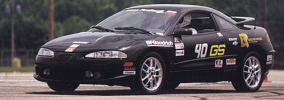Probably the most important thing for a first-time autocrosser to do is to get a copy of the rulebook for the sanctioning body they intend to compete in. Most sanctioning bodies class cars according to the powertrain and number/type of modifications made to the car, so there exists the possibility that a common DSM modification (like a boost controller) may put your car in a class where it will not be competitive without many more modifications.
At the Regional level, the stewards tend to be a little more lenient about what they will allow in a class, but as you get more serious, complience to the letter of the rules becomes very important.
In the SCCA, Turbo DSMs are classed as follows:
- D Stock: for unmodified cars.
- E Street Prepared: for slightly modified cars.
- Street Modified: for highly modified, street-driven cars.
- C Prepared: for purpose-built race cars on race slicks.
- E Modified: Anything goes!
Most street-driven DSMs will be classed in either DS or SM.
Non-turbo DSMs are classed as:
- E Stock for unmodified cars.
- D Street Prepared for slightly modified cars (good luck!)
Stock class cars are allowed:
- Cat-back exhausts
- Stock replacement air filters (not cone filters)
- Any shock with stock-height spring perches
- Any wheel with stock width and offset +/- 1/4"
- Any front sway bar
Most typical street mods are allowed in ESP, except:
- Boost controllers of any type
- Aftermarket turbos
- External wastegates
- Aftermarket BOVs
- Aftermarket brakes
Pretty well all common mods are allowed in Street Modified. SM is the class for DSMs. See the The SM Home Page for more information on SM.
One common newbie mistake is getting all wrapped up in modifying the car, and neglecting the driver. In autocross, Driver Skill is the single most important factor that determines performance
That's so important, it's worth repeating:
As such, the best thing a new autocrosser can do is to buy a good helmet, get the car in good working order, and then go racing - without changing the car for at least one season. Learning to drive well pays much higher dividends than any change to the car ever will.
To go racing, you need:
- A helmet (The latest Snell standard or one Snell standard older)
- Some white liquid shoe polish (to mark tire sidewalls)
- A good tire pressure gauge
- Some way of inflating tires (an air can or a mini pump)
- Sunscreen, and a hat. (it gets hot!)
- Raingear - autocross runs in the rain!
Be sure to arrive early to the event. It takes time to get registered, and you will need to walk the course until you have it memorized.
Perhaps the best way to start your autocross career is to arrive early and prepared, and to tell the fine folks at Registration that you are a newbie, and is there anyone who could help you out? Most events have a designated "newbie chief" who will be happy to take you under his/her wing and show you the ropes.
BEWARE, however, a lot of the "Internet Experts" that hang out on the message forums and mailing lists. There exist trolls and other assorted idiots who will happily lead you down the garden path - and "Wiseman" status on a message board is no promise of competance. Look at their competition record; anybody who has a trophy at an SCCA National Event is probably worth listening to. Someone who talks big, but has no National-level hardware to show for it, is almost certainly talking out of their rectum. Caveat Lector!

